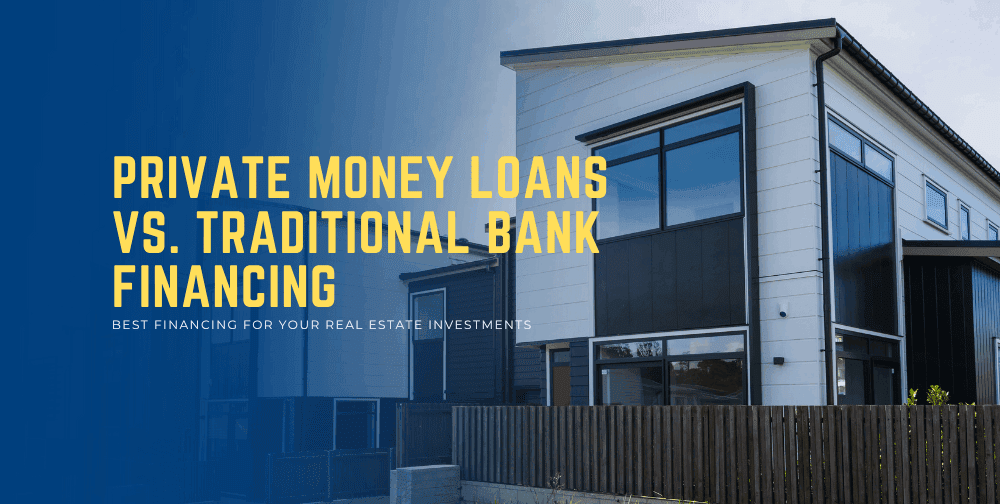Private Money Loans vs. Traditional Bank Financing: Pros, Cons, and Investor Strategies

When it comes to funding real estate investments, two major financing options dominate the lending market: private money loans and traditional bank financing.
Understanding the unique advantages and trade-offs of these loan types is crucial for making the right financing choice for your investment strategy.
While both lending options are used to access capital for property purchases, renovations, or development, they serve entirely different purposes.
Throughout your real estate investing career, selecting the best financing strategies can significantly increase your return on investment, while also potentially saving you hundreds of thousands of dollars or more.
Proper use and structuring of these loans can be the difference between landing a profitable deal and watching it slip away.
Understanding Private Money Loans
The relatively recent rise in interest rates has substantially contributed to investors’ reliance on private credit.
Private individuals and small lending companies control the private lending sector, not banks, because this corner of the financial world thrives on flexibility, speed, and personal relationships.
Unlike traditional banks that are heavily regulated, risk-averse, and constrained by rigid underwriting standards, private money lenders make quick decisions based primarily on a property’s available equity, while also factoring in a property’s location and condition.
These short-term private money loans usually come with higher interest rates and a shorter term duration of 12 to 24 months.
Private money is prevalent in fix-&-flip projects, bridge loans, purchase financing, and time-sensitive acquisitions, where speed and flexibility are essential.
In competitive markets like Los Angeles, opportunities can vanish in days. Since private money loans can be funded in 5 to 7 days and allow borrowers to make all cash offers, they have become an essential financial tool not only reserved for the most sophisticated real estate investors, but for the common investor as well.
As a result, borrowers often turn to private financing from companies like Crescent Lenders to strengthen their offer and secure the winning bid.
Understanding Traditional Bank Financing
Long-term traditional financing comes from banks, credit unions, or mortgage institutions, where strict state and federal regulations must be followed.
Banks offer a variety of traditional mortgage options, but none are more popular than the 30-year fixed-rate mortgage, which is designed for long-term financing stability.
These types of loans offer lower interest rates and longer repayment terms, but come with extensive documentation requirements and focus heavily on a borrower’s financial profile.
Be prepared to provide your credit score, debt-to-income ratio, tax returns, pay stubs, savings account details, as well as additional information regarding the property.
If a borrower is deficient in even one of these areas, the loan application could be rejected.
With extensive underwriting required by big banks, obtaining a traditional loan is often a time-consuming process, taking anywhere from 30 to 60 days to close.
This slower pace makes sense for traditional mortgage loans designed for primary residences, long-term rental properties, or stabilized commercial buildings, but not for hot-market real estate investment opportunities that are likely to move fast.
8 Key Differences
While both financing options provide access to capital at different paces, the process of borrowing from a private lender versus a bank is entirely different. Let’s break down eight key areas where they differ:
1) Source of Funds
Traditional loans come from banks or institutional lenders, while private money loans come from private individuals or small lending companies.
2) Approval Criteria
Traditional lenders focus on the borrower’s credit, income, and financial history, whereas private money lenders base approval primarily on the collateral property’s value, location, and condition.
3) Speed of Funding
Traditional loans can take 30 to 60 days to close, while private money loans often get funded in less than a week.
4) Loan Term
Traditional loans are long-term with a fixed rate, typically lasting 15 to 30 years, whereas private money loans are short-term financing solutions that range from 6 to 24 months.
5) Interest Rates and Fees
Private money loans come with higher interest rates and origination fees compared to traditional financing, which has a lower fee and rate structure.
6) Loan Types
Traditional loans are best for owner-occupied primary residences, while private money loans are ideal for investment property purchases, fix-and-flip projects, or bridging a temporary gap in financing.
7) Documentation
Traditional loans require extensive documentation and strict underwriting, whereas private money loans have minimal paperwork and can be customized to suit the borrower’s needs.
8) Risk Appetite
Big banks are risk-averse and without much tolerance for uncertainty, while private money lenders take on higher risk by focusing on the value of the collateral asset.
When to Choose a Private Money Loan
You need funding fast: Private money loans can close in days instead of weeks, making them ideal for real estate investors competing in hot real estate markets or operating under tight timelines.
You’re purchasing an investment property: Traditional banks often avoid
financing fix-and-flip projects or non-owner-occupied properties, whereas private lenders specialize in these deals.
Your credit isn’t perfect: If your credit score, financial history, or income comes from non-standard requirements and doesn’t meet the strict underwriting
standards of banks, a private lender may still approve you based on property equity.
You need short-term capital: Private loans are outstanding for bridge financing — buying time to renovate, refinance, or sell a property.
The property doesn’t qualify for a bank loan: Unique or distressed properties (like mixed-use buildings or properties needing repairs) may not meet traditional underwriting criteria.
You want flexible terms: Private lenders can structure creative loan terms, such as interest-only payments or custom repayment schedules, to fit your project.
When to Choose Traditional Bank Financing
You want the lowest possible interest rate: Traditional bank loans typically offer significantly lower interest rates than private money loans, making them ideal for long-term financing.
You’re buying a primary residence: Conventional lenders are best suited for owner-occupied homes, where borrowers plan to live in the property for several years.
You have strong credit and stable income: If you have a solid credit score, steady employment, and verifiable income, you’ll likely qualify for favorable rates and terms through a traditional lender.
You’re planning for long-term ownership: Traditional loans are structured over 15 to 30 years, making them a great fit if you intend to hold onto the property rather than sell or refinance quickly.
The property meets standard lending criteria: Well-maintained residential homes or commercial properties in good condition easily qualify for bank
financing, often at better terms than private loans.
You want predictable payments and stability: Traditional loans offer fixed-rate options and amortized payment schedules, giving you long-term consistency and easier budgeting.
How Savvy Investors Combine Both Strategies
Experienced real estate investors understand private and traditional financing aren’t competitors, but instead are independent valuable tools that when used together can create a powerful winning strategy
Many investors use private money to acquire and improve a property, and then once the property has been renovated and stabilized with long-term tenants they transition into a traditional bank loan. This process allows them to “recycle” their capital, reduce borrowing costs, and scale their portfolio more efficiently.
The strategy typically unfolds in three steps:
1 – The investor purchases a property using a private money loan.
2 – Improvements are made to increase the market value and rental income of the property.
3 – Once performing, the investor refinances with a traditional lender at a lower interest rate, paying off the private loan and freeing up funds to pursue the next deal.
This hybrid approach has become the cornerstone of a successful real estate investing and has been coined the BRRRR method, an acronym that stands for buy, rehab, rent, refinance, and repeat.
In fast-paced markets like Southern California, where timing, access to capital, and execution determine success, utilizing these financing options to your advantage will allow you to play chess while everyone else is playing checkers.
Final Thoughts
There is no one-size-fits-all financing option in real estate. The right choice depends on your investment goals, financial profile, and the nature of the property you’re buying. Private money loans offer speed, flexibility, and accessibility, while traditional bank loans provide low-cost, long-term stability.
For short-term projects or when timing is critical, private lending can be the difference between closing a deal and losing it. Once your property is stabilized and producing income, transitioning to bank financing helps lock in lower rates and maximize returns.
Crescent Lenders is a locally owned private money lender based in Los Angeles, California. They specialize in helping investors bridge the gap between opportunity and long-term success. Their private money loans are designed for California investors who need fast, reliable funding to close deals confidently. Whether you’re flipping, developing, or repositioning real estate, Crescent Lenders provides the capital and expertise to help you move forward without delay.

Source: Private Money Loans vs. Traditional Bank Financing: Pros, Cons, and Investor Strategies



